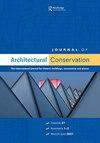Editorial
IF 0.5
3区 艺术学
0 ARCHITECTURE
引用次数: 0
Abstract
Preventing dangerous climate change, and therefore reducing carbon dioxide emissions and energy consumption of the building stock, is a key priority for the European Union. Initially, this was (mainly) directed towards new buildings, yet in the last years also historic buildings become more and more concerned. All of our built heritage, listed or not, is a witness of our past, our history and our constructive traditions. It adds significantly to the quality and charm of our built environment and therefore ensures the added value of European cities and countryside. It is clear that a sustainable society cannot be built without respect for its history, but it must also be anchored in the present and ensure its future use. Nevertheless, the energetic and comfort optimization of these buildings is not yet generally accepted and often is subjected to delicate discussions. Therefore, it is the duty of the present generation of experts to preserve our built heritage in a way it reflects and is adapted to the economic, societal, environmental, comfort, and energy context of today, while ensuring the absolute preservation of the heritage’s intrinsic values. This two-track policy is an absolute necessity: after all, it is common knowledge that uncomfortable and energy-consuming buildings are not likely to be used, accelerating their decay and finally condemning them to be lost completely for the future generations ... The above-mentioned formed the basis for the Belgian Building Research Institute to organize and host the Second International Conference on Energy Efficiency and Comfort of Historic Buildings (EECHB2016) in October 2016 in close collaboration with the public heritage institutes from Brussels, Flanders, and Wallonia. Whereas the papers at the conference ranged from assessment and monitoring, to regulations, management and training, as well as sustainable interventions, this special issue of the Journal of Architectural Conservation puts forward an extended version of four of these papers, illustrating different possibilities and showing the necessity of interaction between science and heritage in order to make our built heritage future proof. The first paper by G. Leijonhufvud and T. Broström shows how standardization in relation to historic buildings has taken a new direction during the last years. It emphasizes on how energy standards, focusing on decision processes, can solve some of the problems related to the conventional outcome-oriented approach of standards by opening up for a wider set of solutions. Thereafter, R. Kilian, S. Bichlmair, and M. Krus provide a technical paper, discussing new insights on how to optimize the heating system of historic houses. Being one of the most adopted alterations when improving the energy consumption and comfort of old buildings, the paper discusses four different suitable heating systems by an accurate onsite monitoring of them within the Alte Schäfflerei (Old Cooperage; 1760) of the Benediktbeuern Monastery. Whereas most actions on heritage buildings are oriented towards buildings from long ago, in recent years heritage experts are more and more confronted with the innovative and experimental buildings from the twentieth century. As these are particularly vulnerable to inappropriate retrofit, the paper of R. Atkins, R. Emmanuel, and C. Hermann presents an assessment methodology that systematically integrates conservation with energy performance, economic feasibility, and construction practices for the mid-twentieth century buildings. The社论
防止危险的气候变化,从而减少二氧化碳排放和建筑的能源消耗,是欧盟的一个关键优先事项。最初,这(主要)是针对新建筑,但在过去的几年里,历史建筑也越来越受到关注。我们所有的建筑遗产,无论是否被列入名录,都是我们过去、历史和建设性传统的见证。它大大提高了我们建筑环境的质量和魅力,从而确保了欧洲城市和农村的附加值。显然,如果不尊重其历史,就不可能建立一个可持续的社会,但它也必须立足于现在,并确保其未来的利用。然而,这些建筑的能量和舒适度优化尚未被普遍接受,并且经常受到微妙的讨论。因此,当代专家有责任保护我们的建筑遗产,以一种反映并适应当今经济、社会、环境、舒适和能源背景的方式,同时确保遗产的内在价值得到绝对保护。这种双轨政策是绝对必要的:毕竟,众所周知,不舒服、耗能的建筑不太可能被使用,加速了它们的衰败,最终导致它们在未来几代人面前完全消失……在上述基础上,比利时建筑研究所与布鲁塞尔、佛兰德斯和瓦隆尼亚的公共遗产研究所密切合作,于2016年10月组织并主办了第二届国际历史建筑能效与舒适度会议(EECHB2016)。会议上的论文涵盖了评估与监测、法规、管理与培训以及可持续干预等方面,本期《建筑保护杂志》特刊对其中四篇论文进行了扩展,阐述了不同的可能性,并展示了科学与遗产互动的必要性,以使我们的建筑遗产能够适应未来。G. Leijonhufvud和T. Broström的第一篇论文展示了与历史建筑相关的标准化如何在过去几年中采取了新的方向。它强调能源标准如何通过开放更广泛的解决方案来解决与传统的以结果为导向的标准方法相关的一些问题,重点是决策过程。此后,R. Kilian, S. bichlmaair和M. Krus提供了一篇技术论文,讨论了如何优化历史建筑供暖系统的新见解。作为提高老建筑能耗和舒适度的最常用的改变之一,本文通过对老建筑Schäfflerei (old Cooperage;1760年)的本笃修道院。虽然大多数关于遗产建筑的行动都是针对很久以前的建筑,但近年来遗产专家越来越多地面对20世纪以来的创新和实验建筑。由于这些建筑特别容易受到不适当改造的影响,R. Atkins、R. Emmanuel和C. Hermann的论文提出了一种评估方法,该方法系统地将节能与能源性能、经济可行性和20世纪中期建筑的施工实践相结合。的
本文章由计算机程序翻译,如有差异,请以英文原文为准。
求助全文
约1分钟内获得全文
求助全文

 求助内容:
求助内容: 应助结果提醒方式:
应助结果提醒方式:


